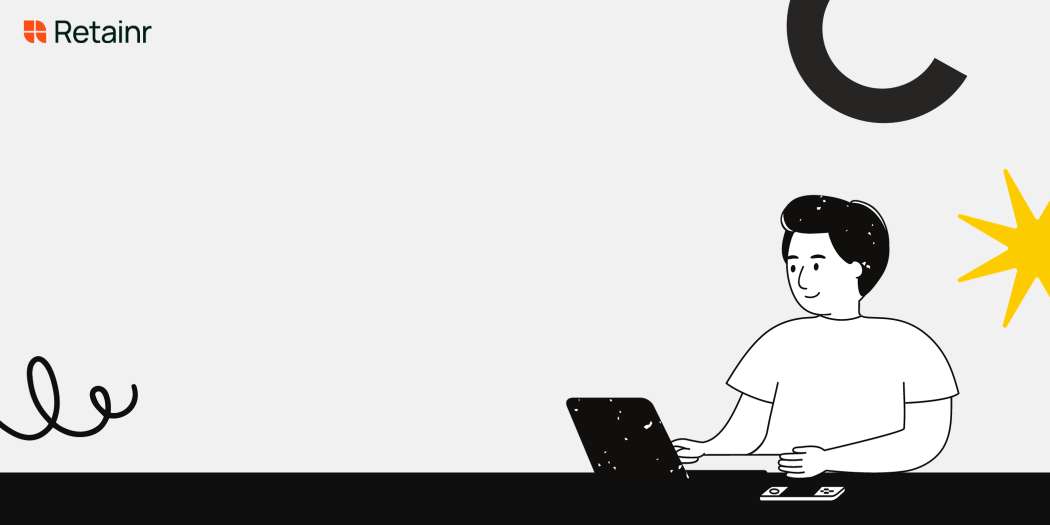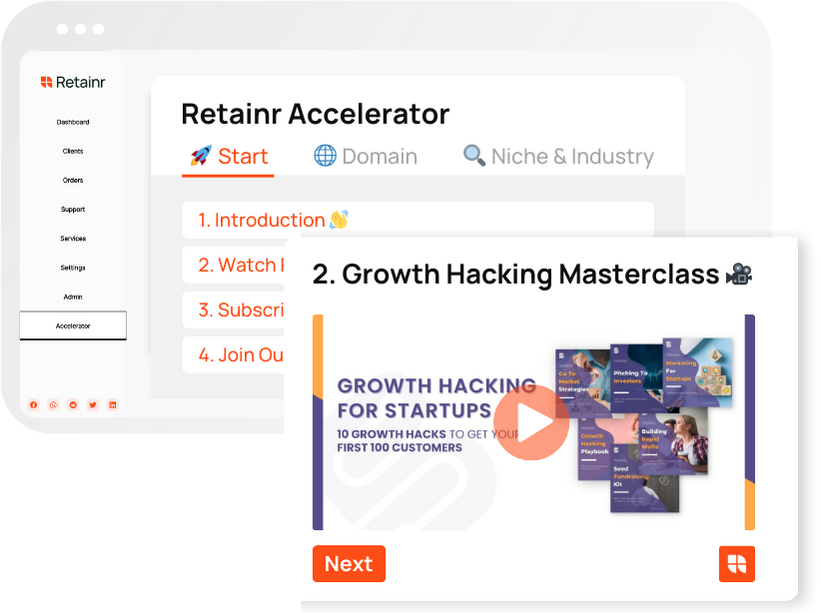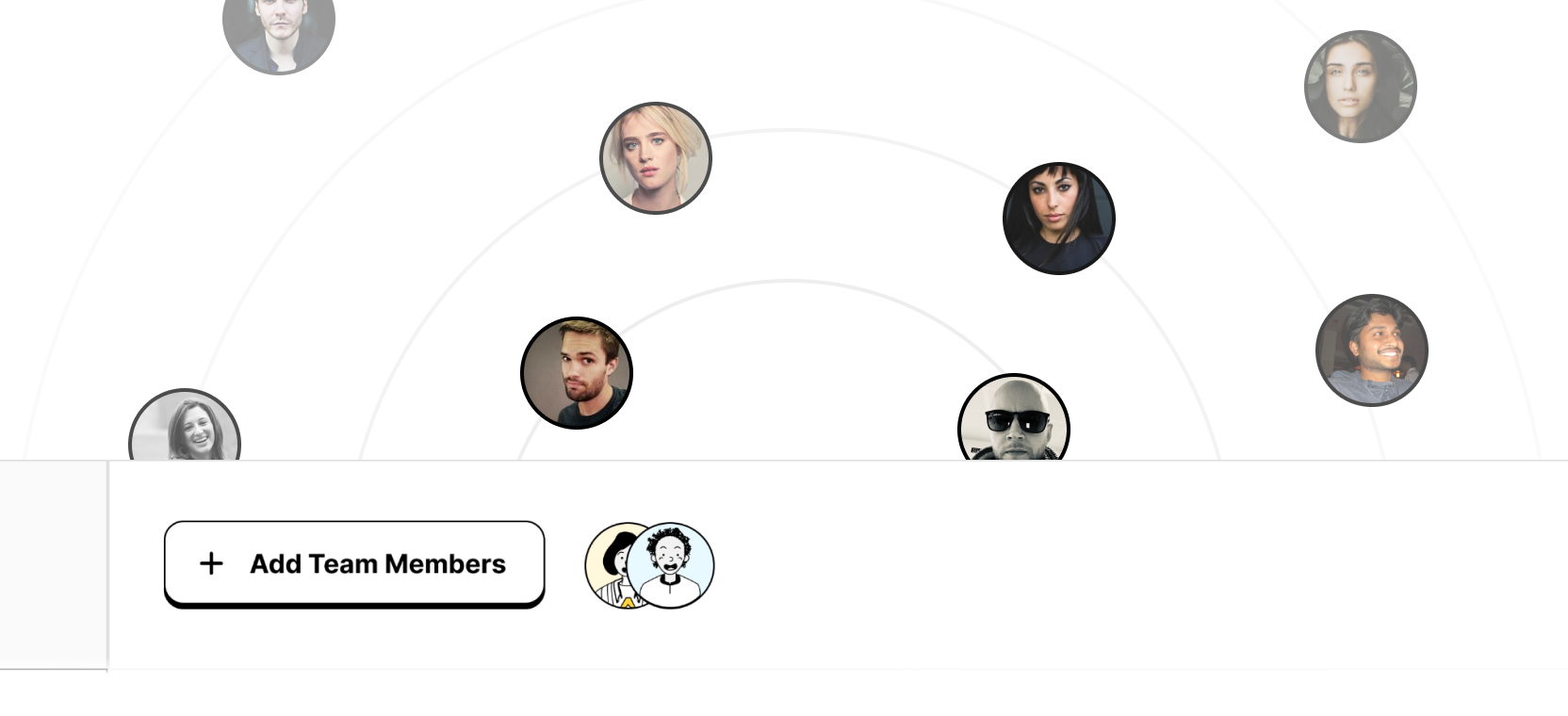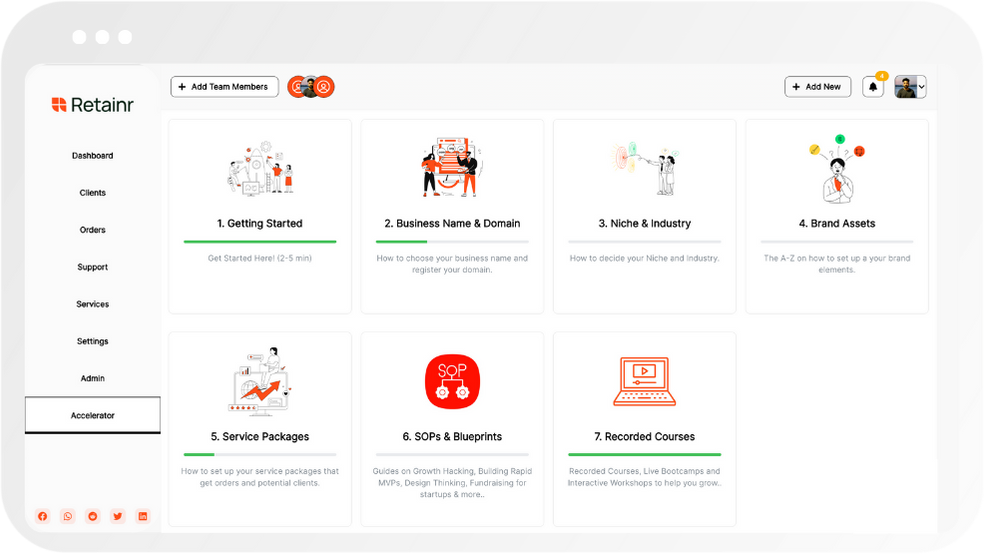
8 Steps to Creating a Successful Client Project Dashboard
Build with Retainr
Sell your products and services, manage clients, orders, payments, automate your client onboarding and management with your own branded web application.
Get Started1. What are the 8 steps to creating a successful client project dashboard?
Overview of 8 Steps to Creating a Successful Client Project Dashboard
Creating a client project dashboard involves a number of steps designed to ensure the most relevant and necessary information is easily available to all stakeholders. These eight steps provide a roadmap to designing a dashboard that not only keeps everyone informed but also assists in effective project management.
Stepwise Breakdown
- Identify Stakeholder Needs: This involves understanding what type of information different stakeholders require at various stages of the project.
- Outline Relevant Metrics: Define what metrics are most relevant to the project and will give an accurate representation of its status.
- Design Dashboard Layout: Prioritize and arrange the metrics to create a visually appealing and intuitive dashboard.
- Automate Data Collection: Use appropriate tools and software to automate the collection and updating of data on the dashboard.
- Test the Dashboard: Ensure the dashboard is working as expected and that the data displayed is accurate and timely.
- Train the Users: Provide necessary training to the stakeholders on how to understand and use the dashboard effectively.
- Launch the Dashboard: Officially release the dashboard for use in the project management process.
- Regularly Review and Update: As the project progresses, review and adjust the dashboard as necessary to stay relevant and helpful.
Detailed Representation of the Steps
| Steps | Description |
|---|---|
| Identify Stakeholder Needs | Find out the information needs of all the project stakeholders for a well-informed result |
| Outline Relevant Metrics | Highlight the metrics that effectively illustrate the project's progress |
| Design Dashboard Layout | Create a user-friendly layout that clearly displays necessary information |
| Automate Data Collection | Implement automated data collection for an efficient and up-to-date dashboard |
| Test the Dashboard | Carry out tests to ensure the functionality of the dashboard |
| Train the Users | Equip all stakeholders with the knowledge to use and understand the dashboard |
| Launch the Dashboard | Release the dashboard officially for active use |
| Regularly Review and Update | Reassess the dashboard's relevance periodically and make necessary updates |
2. Why is it necessary to follow these steps in creating a client project dashboard?
Reasons for Following Steps in Creating a Client Project Dashboard
There are numerous compelling reasons to follow the outlined steps in creating a client project dashboard. To begin with, a structured process ensures consistency in dashboard design. This is particularly important when your organization is handling multiple projects, often concurrently. Each dashboard will have a uniform structure, making it easier to manage and analyze data across different projects.
- Improved communication: Following a guided process in creating a client dashboard allows all stakeholders to have a clear understanding of the project status, deadlines, and key metrics. This promotes transparency and improves communication within the team.
- Error reduction: By following the correct steps in creating a dashboard, you minimize the chances of making errors such as omitting critical data or including irrelevant information which can potentially cause misunderstanding or misinterpretation of data.
- Better project management: A well-designed dashboard facilitates better project management as it provides a broad view of the project, tracking its progress and identifying any potential bottlenecks or risks that can impact the project timeline.
- Stakeholder satisfaction: A comprehensive and easy-to-understand dashboard increases customer satisfaction as it shows the project's progress in real-time, assuring clients that their project is moving forward as planned. This transparency can bolster customer trust and confidence in your business operations.
A comparative table below elucidates how a standardized dashboard creation process enhances overall project management effectiveness.
| With Standardized Dashboard Creation | Without Standardized Dashboard Creation | |
|---|---|---|
| Consistency | High level of consistency; easy data comparison across multiple projects. | Lacks consistency; difficult to compare data, leading to probable errors. |
| Communication | Improves communication within the team; fewer misunderstandings. | Possibility for more misunderstandings due to inconsistent/different layouts and inclusion of irrelevant data. |
| Error Reduction | Minimized chances of errors; data is accurate, reliable and easily understandable. | Higher potential for errors, possibly affecting project outcomes. |
| Project Management | Promotes better project management; easy tracking of project progress. | Challenging to track project progress, possibly leading to delays or flawed execution. |
| Client Satisfaction | Clients have a clear understanding of project progress, increasing their trust in your services. | Less transparency might breed mistrust or dissatisfaction among clients. |
3. How does defining the dashboard's purpose contribute to its success?
Importance of Defining the Dashboard's Purpose
Defining the dashboard's purpose is a critical step in setting up a successful client project dashboard. A clear and precise purpose gives coherence and direction to the dashboard's development. Without it, the dashboard might lack focus, making it challenging to interpret and use. This is because it can end up displaying too much or inadequate data, neither of which is valuable to the intended user.
- Improves Focus: Clearly stating the purpose of the dashboard can help pinpoint exactly what type of data should be presented. This can prevent bloating the dashboard with too much irrelevant data or not providing enough useful data.
- Enhances Usability: If a dashboard’s purpose is well-defined, users will find it easier to navigate and interpret. The key indicators and metrics would be well aligned to the set objectives.
- Boosts Efficiency: When a dashboard serves a defined purpose, it can streamline workflows by focusing on metrics that matter most. Employees will avoid wasting time on irrelevant metrics.
The Role of a Dashboard’s Purpose in Success
The success of a client project dashboard largely depends on how well its purpose is defined. A well-articulated purpose helps in creating a dashboard that aligns perfectly with the needs of the project team or stakeholders. It helps to maintain its relevance, making it an indispensable tool for managing and monitoring project performance. Please refer to the table below to understand how the purpose of a dashboard aids in its success.
| Points | Description |
|---|---|
| Relevance | By defining the dashboard's purpose, it consistently delivers relevant metrics and KPIs that matter most to the stakeholders. |
| Decision-making | With a clear purpose, a dashboard can assist in strategic decision-making by presenting an accurate picture of project progress and performance. |
| Efficiency | A purpose-driven dashboard can contribute to improved efficiency by highlighting areas needing attention and facilitating swift action. |
4. Can you discuss more about identifying key metrics in relation to creating a client project dashboard?
Understanding Key Metrics for a Client Project Dashboard
In setting up a highly effective client project dashboard, it is essential to identify the key metrics that accurately mirror the progress and success of the project. The key metrics can vary depending on the nature of the project, however, a few general categories can be used as a starting point:
- Project Performance Metrics: This may include metrics that give information about the current status or progress of the project. For instance, completion percentage, milestones reached, work accomplished against the planned work, etc.
- Financial Metrics: Here, you might want to consider metrics such as project expenses, budget variances, financial forecasts, and return on investment.
- Quality Metrics: Metrics such as defect density, rework efforts, and customer satisfaction index come under this bracket.
- Risk and Issue Metrics: These may include risk impact/ probability, open/closed issues, issue resolution time, and major risks or issues identified.
- Team Performance Metrics: Metrics such as team productivity, resource utilization, and team member satisfaction are monitored here.
Selecting Key Metrics for Your Dashboard
Selecting the key metrics for your dashboard is a task that requires a keen understanding of the project goals, environment, and stakeholders. It's essential to avoid irrelevant or redundant metrics, as they can lead to confusion. Below are some guidelines while choosing the right metrics:
- Relevance: The metrics you choose should provide meaningful information related to the project's progress and performance.
- Clarity: Choose metrics that are easy to understand and interpret by all stakeholders. A mix of both qualitative and quantitative metrics often provides a balanced view.
- Actionable: Metrics should drive actions. If a metric does not provoke a decision or action then its utility should be reconsidered.
- Timely: Choose metrics that can be updated in real-time, or with a frequency that makes it relevant at the time of decision-making.
Example of Key Metrics on a Client Project Dashboard
The table below illustrates examples of some key metrics that could feature on a client project dashboard:
| Metric | Description |
|---|---|
| Project Completion Percentage | Measures the amount of completed work against the total work planned |
| Budget Variance | A measure of the difference between the planned cost of the project and the actual cost |
| Open Issues | Count of unresolved issues that are pending action |
| Team Productivity | Measures the output of the project team divided by the amount of time and resources used |
5. How important is it to design the dashboard layout during its creation?
The Significance of Dashboard Layout Design during Creation
Crafting the layout of your client project dashboard during its creation carries significant weight. Firstly, it aids with clarity. An efficient dashboard should present data in a clear, concise manner. This cannot be achieved without a good layout design. Secondly, the design of the dashboard layout determines its usability. A well-designed layout makes your dashboard spontaneous and straightforward, boosting user experience. Lastly, an excellent layout design embodies aesthetic appeal. Dashboards not only need to be useful, but they also need to be pleasant to look at. This enhances user engagement and influences frequent return rates.
Key Elements to Consider When Designing Dashboard Layout
You should deliberate on several factors while making your dashboard layout. These include:
- Arrangement: How you organize your data impacts user comprehension. Set essential data on the left or top of the dashboard, where users typically start viewing.
- Placement of Controls: Position them at the top or side of your dashboard for easy access.
- Consistency: Ensure the design elements are consistent throughout your dashboard.
- Size: The size of your dashboard should correspond with its complexity.
A Sample Dashboard Layout Design
Below is an example of how a dashboard layout can be presented using HTML.
| Sections | Content |
|---|---|
| Top | Dashboard controls and filters |
| Left | High priority data or tasks |
| Right | Low priority data or tasks |
| Bottom | Links, footnotes, and additional resources |
6. What should I consider when selecting the right tool to create a client project dashboard?
Choosing the Right Tool
Several factors must be considered when choosing the right tool for creating your project dashboard. Your choice will affect how effectively you can track, measure, and communicate progress with your clients. Consider factors like:
- Usability: How easy is it to use? Will it require significant training, or can your team hit the ground running?
- Customizability: Is the tool flexible enough to tailor to your specific needs, or is it too rigid?
- Integration: How well does it integrate with other tools you're using?
- Scalability: Is the tool capable of growing with your business and handling more complex projects in the future?
- Cost: Will it fit within your budget?
Available Tools
There's a wide selection of project management tools available in the market, each with its unique features and offerings. Here are a few examples:
| Tool | Pros | Cons |
|---|---|---|
| Asana | Intuitive interface, good team collaboration features | Limited reporting capabilities |
| Trello | Flexibility in managing tasks, good for small projects | Can become messy for larger projects |
| Jira | Powerful for software development projects, robust reporting | Steep learning curve, can be overwhelming |
Client's Preferences and Needs
Remember, the client's needs and preferences should always be at the forefront of your choice. Therefore, take into account:
- Visibility: How comfortable are they with the level of visibility provided by the tool?
- Accessibility: How easy it is for them to access and understand the dashboard?
- Feedback process: Does the tool allow for easy communication and feedback?
- Security: How secure is the tool, especially if dealing with sensitive data?
7. Can you provide some practical tips in adding data to the dashboard for its effectiveness?
Understand Your Client's Needs
Before filling in data in your client project dashboard, it's crucial to understand what your client's needs are. This means identifying what metrics are most meaningful to them. You can do this by having a meeting with your client where you can ask about their specific goals for the project. Here's a simple table showing the possible client goals, along with the corresponding data to add to the dashboard:
| Client Goals | Dashboard Data |
|---|---|
| Increase sales | Revenue growth, Sales conversions |
| Improve customer satisfaction | Customer reviews, NPS Score |
Choose the Right Visualization Tools
Choosing the right visualization tools also plays a major part in adding data to the dashboard. Here are some tips on select visualization tools:
- For comparing values, use bar or column charts.
- For measuring progress, a gauge or progress bar can be used.
- To show data over time, line charts or area charts are the way to go.
Maintain Data Accuracy
Nothing ruins a dashboard's effectiveness than inaccurate data. Thus, maintaining data accuracy is paramount. Below are some tips on doing so:
- Ensure your data sources are reliable.
- Regularly update your dashboard to reflect real-time or the most recent data.
- Use automation tools where applicable to reduce manual input errors.
8. How often should I update the data on the client project dashboard?
Update Frequency
The frequency of updating your client project dashboard depends on several factors such as project complexity, the project's phase, and client specifications. As a rule of thumb, data on a project dashboard should reflect the most recent and relevant information. This may require daily updates for complex, fast-paced projects or might be less frequent like weekly or biweekly updates for projects that have a slower pace or are in the planning phase.
A few points to keep in mind when deciding the update frequency are:
- Client specifications: Your client may have specific demands for how often they want to see updated data.
- Project stage: During critical stages of the project, more frequent updates may be required.
- Project complexity: More complex projects may require frequent updates to manage intricate details effectively.
Data Updates and Stakeholder Communication
Along with the frequency, the mode of communication regarding these updates is also important. Here you can use different tables or graphical representations to present updated data to your clients and other stakeholders effectively. A simple table, such as the one below, can easily communicate when and what updates have been made.
| Date | Type of Update | Summary |
|---|---|---|
| MM/DD/YYYY | Progress Report | Completed task XYZ, began task ABC |
In conclusion, the key to successful client project dashboard management is striking a balance between providing updated, relevant information and avoiding information overload. The update frequency should align with the project's needs and facilitate effective communication with the stakeholders.
9. Why is it crucial to get feedback after creating the client project dashboard?
Significance of Client Feedback
When you create a client project dashboard, feedback from the clients or users is instrumental for numerous reasons. It can point out features that may not work as efficiently as anticipated, highlight areas that lack intuitiveness for easy use, and provide insight into the overall user friendliness of the dashboard. This feedback can then be leveraged to optimize and improve the dashboard. Let's see some of the main aspects:
- Identify problem areas: Feedback helps in recognizing issues that you might have overlooked during the project dashboard creation.
- User Experience: The prime goal of a project dashboard is to facilitate the client's tasks. Feedback can draw light on how well the dashboard is achieving this aim.
- Room for Improvement: Even when the dashboard is functioning well, there's always scope for enhancement. Feedback can disclose areas where such improvements can be made.
Benefits of Feedback in Tabulated Form
To better illustrate the benefits of getting feedback after creating a client project dashboard, we will provide a tabulated representation.
| Basis | Without Feedback | With Feedback |
|---|---|---|
| Performance | May leave room for problems and may not meet client's expectations. | Ensures that the dashboard is effective and issues have been addressed. |
| Client Satisfaction | Without feedback, it could result in lower client satisfaction. | Feedback allows for immediate enhancements leading to better client satisfaction. |
| Future Improvements | Without feedback, improvement opportunities might be overlooked. | Feedback paves the way for ongoing enhancements. |
10. How can I improve a client project dashboard after considering the feedback received?
Implementing Changes Based on Feedback
After collecting feedback from the users of your client project dashboard, the next critical step is to implement necessary changes to improve its functionality. Start by categorizing the feedback, rank them based on priority and work your way in introducing these improvements. There are several ways on how to do this:
- Adjust Dashboard Layout: Re-arrange elements based on user preference. Ensure that the most important data stands out and is easy to locate.
- Incorporate Additional Features: Add necessary features suggested by users to improve usability and efficiency of the dashboard.
- Remove Less Important Insights: If users find certain data or visualizations unhelpful, consider removing them to reduce clutter.
- Enhance Visual Appeal and Readability: Based on feedback, alter the color scheme, fonts, and other visual elements to improve readability and user experience.
- Improve Dashboard’s Speed and Performance: Make sure that the dashboard loads quickly and functions smoothly even with a lot of data.
Testing the Improved Dashboard
Once you have implemented the changes, it’s essential to test the updated dashboard thoroughly. Verify that all the modifications work as intended, and there’re no conflicts or glitches caused due to the changes. Note down any issues, and rectify them before the dashboard goes live. Detailed testing could include:
| Testing Activity | Description |
|---|---|
| Functionality Test | Ensures all the features and elements of the dashboard work correctly. |
| Usability Test | Checks if the dashboard is user-friendly and the data is easy to comprehend. |
| Performance Test | Measures how quickly the dashboard loads and responds to user activities. |
| Device Compatibility Test | Verifies that the dashboard works well across various devices and screen sizes. |
Continuous Improvement
In this fast-paced digital world, user expectation and technology keep changing rapidly. Hence, it’s crucial to keep evolving your client project dashboard to meet these changes. For continuous improvement:
- Periodically collect user feedback to identify any current issues and scope for improvement.
- Introduce new features to cater to emerging user needs.
- Keep an eye on the latest technology trends and integrate them into your dashboard for enhanced user experience.
- Regularly review and update the overall strategy of your client project dashboard.
Conclusion
Summary of Creating a Successful Client Project Dashboard
This blog post focuses on the eight crucial steps in creating an effective project dashboard geared towards satisfying clients' needs and improving project management. The steps include evaluating project goals and key performance indicators (KPIs), choosing the right data visualization tools, incorporating real-time data, ensuring data accuracy, and making the dashboard interactive and user-friendly. The ultimate goal is to create a dashboard that not only offers critical project insights but also improves client communication and decision making.
How Retainr.io can Help
Retainr.io is a powerful tool that can help you implement these steps. This whitelabel software enables you to sell, manage clients, orders, and payments seamlessly. With Retainr.io, you can create a personalized, efficient, feature-rich project dashboard that provides real-time data, enhances decision making, and fosters effective communication with clients.
The Unique Capabilities of Retainr.io
One of the unique selling points of Retainr.io is the ability to white label your applications. This means you can brand your project dashboard in line with your company's identity, thereby offering clients a consistent, personalized experience.
Furthermore, the platform offers various project management features that ensure efficient client, order, and payment management. Whether you're tracking KPIs, updating project information, or invoicing clients, Retainr.io simplifies these processes, letting you focus on the significant aspects of managing your projects.
Without a doubt, Retainr.io is the go-to software solution for creating a successful client project dashboard.
Get Started with Retainr.io Today
Visit our website, www.retainr.io, to start creating your successful client project dashboard today. By choosing Retainr.io, your projects, clients, and profits are well managed.
Boost Your Agency Growth
with Retainr Accelerator
Uncover secrets, strategies, and exclusive blueprints to take your agency's growth to the next level — from marketing insights to effective presentations and leveraging technology.

SOPs, Cheatsheets & Blueprints
Leverage 50+ SOPs (valued over $10K) offering practical guides, scripts, tools, hacks, templates, and cheat sheets to fast-track your startup's growth.
Connect with fellow entrepreneurs, share experiences, and get expert insights within our exclusive Facebook community.
.jpg)

Join a thriving community of growth hackers. Network, collaborate, and learn from like-minded entrepreneurs on a lifelong journey to success.

Gain expertise with recorded Courses, Live Bootcamps and interactive Workshops on topics like growth hacking, copywriting, no-code funnel building, performance marketing and more, taught by seasoned coaches & industry experts.

.jpg)

.jpeg)


